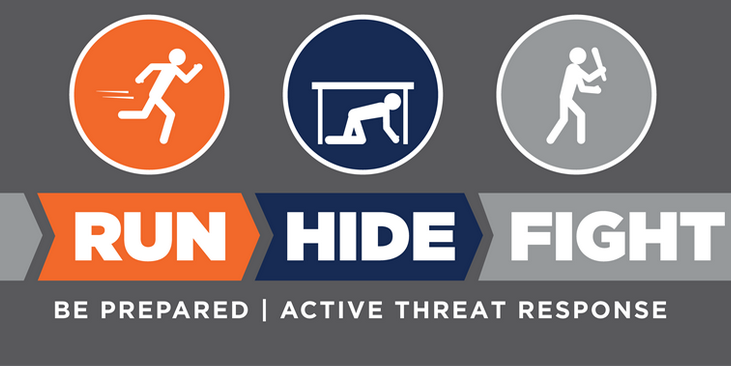Active Shooter
The UNCSA Department of Police and Public Safety teaches Active Shooter Response Training to mentally prepare our campus for violent attacks. Participants who attend Active Shooter Response Training learn about the actions that everyday people can take to survive a dangerous encounter with a violent intruder. Active Shooter Response training can be conducted in your office/department to evaluate the current security of your space. During the training, participants are taught to utilize each of the principles learned during the lecture so they can understand the benefits of each strategy. Participants are taught the value of teamwork in overcoming a potential attacker.
Contact Clarisse Davis, Emergency Manager, at davisc@uncsa.edu or 336-770-3321 more information about Active Shooter Response Training and to request training.
During an active shooter incident, there are three actions you can do to protect yourself and others:
Run
First and foremost, if you can get out, do so.
- If there is an escape path, attempt to evacuate.
- Evacuate whether others agree to or not.
- Leave your belongings behind.
- Help others escape if possible.
- Prevent others from entering the area.
Hide
If you can’t get out safely, you need to find a place to hide. Act quickly and quietly. Try to secure your hiding place the best you can.
- Lock and/or blockade the door.
- Silence your cell phone/pager.
- Hide behind large objects.
- Remain very quiet.
- Do not huddle in groups.
Your hiding place should:
- Be out of the shooter’s view.
- Provide protection if shots are fired in your direction.
- Not trap or restrict your options for movement.
Fight
As a last resort, and only if your life is in danger...whether you’re alone or working together as a group, fight.
- Attempt to incapacitate the shooter.
- Act with physical aggression.
- Improvise weapons.
- Commit to your actions.
When Law Enforcement Arrives
- Remain calm and follow instructions.
- Put down any items in your hands (i.e. bags, jacket).
- Keep your hands visible at all times.
- Avoid pointing or yelling.
- Avoid quick movement toward officers such as holding on to them for safety.
- Know that help for the injured is on its way.
First Responders on the scene are well-trained and are there to stop the shooter. They are not there to evacuate or tend to the injured.
Information you should provide to a Law Enforcement and Communications Officer:
- Location of the shooter(s)
- Number of shooter(s)
- Physical description of shooter(s)
- Number and type of weapons held by shooter(s)
- Number of potential victims at the location






